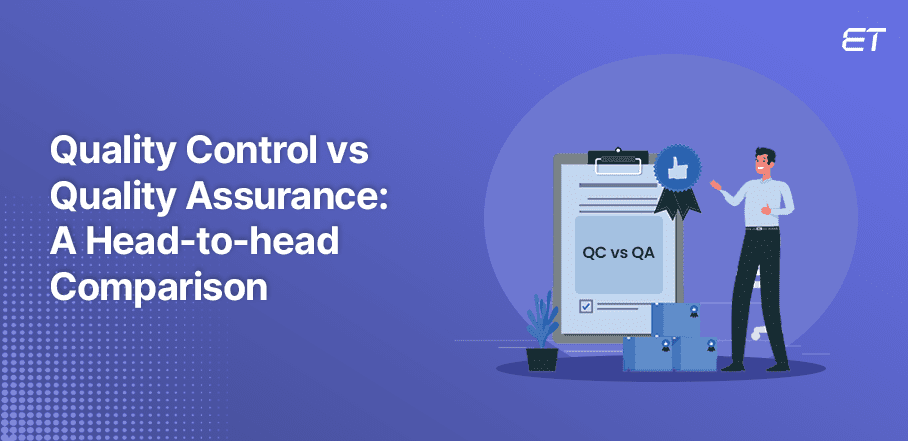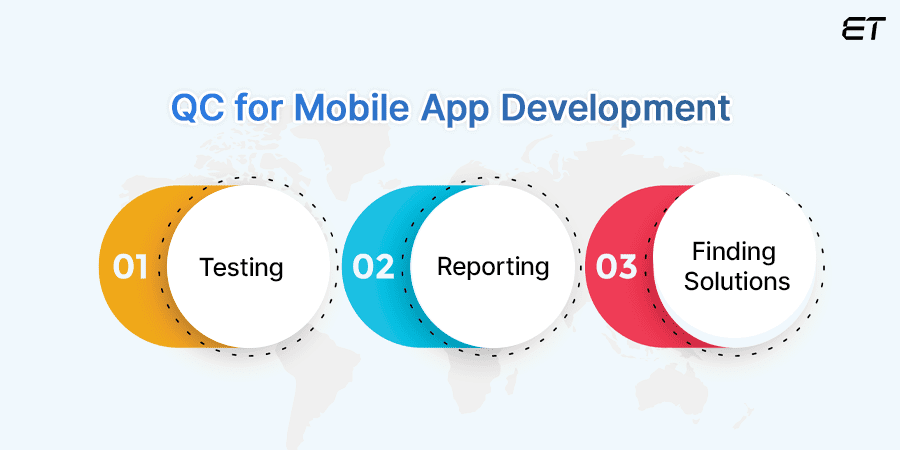Key Takeaways
- Quality control (QC) identifies and corrects defects in a developed software
- Quality assurance (QA) aims at preventing defects to provide the best possible product
- QC involves the systematic execution of a program and mainly includes the testing team
- QA is a preventive technique and spans across the entire development life cycle
- Both QC and QA are vital activities that are prime offerings of established software companies
Software Quality Assurance vs Quality Control: In-depth Comparison
‘Quality is everyone’s responsibility.’ – W. Edwards Deming. You can access several quality control vs quality assurance comparisons on the internet. But do you know what they have in common?
All of them distinguish between QC and QA. Now, read Deming’s quote once again. You will realize that the concepts can be different. However, we should include both activities to ensure top-notch quality that holds everyone accountable.
A combination of both ‘control’ and ‘assurance’ contributes to producing a high-class product. As a B2B professional, it thus becomes vital to understand quality control vs assurance to allocate your resources wisely.
This blog explains quality control vs quality assurance. It also sheds light on combining both concepts to achieve stellar results.
What is Quality Control in Software Testing?
Before delving deep into quality control vs quality assurance, let’s understand each term in simple words.
Control implies keeping things under set limits to avoid any adverse impact. In software development, quality control is a process to ensure your digital product meets the expected standards.
Here are the main components of quality control to understand:
- Identification of issues: Find bugs, errors, or areas where a software, portal, or website doesn’t meet the desired output.
- Adherence with set standards: The software or website should justify the set standards pertaining to performance, security, and usability.
Overall, QC is a reactive process. It focuses on identifying defects rather than preventing them. It mainly analyzes the quality of a final product.
What is Quality Assurance in Software Testing?
Quality control vs assurance can be confusing as you can feel they’re interchangeable terms. However, ‘assurance’ is quite different than ‘control.’
Assurance is a feeling that you are confident about a specific thing. Now, in software development, assurance implies that your client feels assertive about the outcome of a digital product.
So, quality assurance is a process that focuses on preventing defects. It includes a sequence of tasks the entire team should follow to deliver a top-quality digital product.
Note: When we mention ‘digital product,’ the term encompasses websites, web portals, mobile apps, web applications, or customized software.
Differences Between Software Quality Control and Quality Assurance
There are direct differences between quality control and assurance. This section explains each point differentiating the two processes.
Focus Area
Whenever you hear these two terms, remember the following points:
- Quality control focuses on ‘identification.’
- Quality assurance emphasizes on ‘prevention.’
These simple words are sufficient to differentiate the two activities in terms of their application. In quality control, the engineers pay attention to testing activities.
The testing activities in QC include the following:
- Laboratory testing
- Software analysis
- Product Sampling
- Validation
On the other hand, quality assurance deals with standardizing and implementing processes. QC is mainly executed in the final stage before delivering the end software.
QA is a continuous process that ensures the maintenance of quality throughout the development span. So, before hiring a software quality team, you should always understand the main intention of quality control vs quality assurance.
Approach
In terms of approach, quality control is more reactive. A QC team finds out flaws, bugs, or errors in software after development.
On the contrary, quality assurance is proactive. This concept prevents defects from occurring in the first place. So, documentation is crucial for the success of quality assurance.
In the quality control vs quality assurance comparison, you need to understand the following:
- QC includes various types of tests like unit, integration, and system. In addition, some brands implement user acceptance testing
- QA begins with requirement analysis and ends with risk management. Between these steps, the organization needs to plan process improvement, reviews, and conduct code audits
As you can see, the approach is quite different in both cases. Thus, it is crucial to know the approach behind a service’s implementation before choosing it.
Team Strength
By now, it must be easier to guess which activity requires a large team. In quality control, the testing team is in charge of identifying errors in software.
So, the team size is small. On the other hand, quality assurance is a continual process involving professionals with a broader skill set. A QA team should be proficient in collaborating with developers, decision-makers, and designers.
The sheer increased involvement of stakeholders contributes to greater team strength in the case of quality assurance.
Practical Example
Let’s explain quality control vs quality assurance with a hypothetical example.
Consider you’re testing a mobile application. Your app has features like product browsing and an active cart.
Now, a typical QC process will involve the following steps:
- Unit testing: Logic, image loading, etc.
- Integration testing: Item addition, checkout, etc.
- Usability testing: Make a purchase.
Through these activities, a quality control team can find issues and implement fixes accordingly.
Now, let’s consider adding a new feature to this mobile app. Before initializing coding, the quality assurance team will define the requirements for this feature.
Assume this feature is a customer loyalty program. Here are the QA steps:
- Analysis: Why do you need this feature? The QA team finds answers like driving repeat purchases or increasing engagement
- Risk management: The QA team also identifies risks like the complexity of the loyalty program
- Definition of the process: After analyzing all the aspects, the quality assurance team can suggest testing strategies
So, the QA process ensures the proper design of the loyalty program feature.
Quality Assurance vs Quality Control: Key Differences
The following table includes all the relevant differentiation points of the quality control vs quality assurance comparison.
| Feature | Quality Control (QC) | Quality Assurance (QA) |
| Focus | Identification of defects | Prevention of defects |
| Approach | Reactive – Finds flaws after development | Proactive – Prevents flaws from occurring. |
| Activities | Testing (unit, integration, system, user acceptance) | Requirement analysis, process improvement, reviews, code audits, risk management. |
| Team Strength | Smaller team with strong testing skills | larger team with broader skillset (collaboration, SDLC, risk management) |
| Hypothetical example | Testing a mobile app for issues in browsing, adding items to cart, and checkout | Defining requirements and risks for a new feature like customer loyalty program |
Software Quality Control vs Quality Assurance: The Endnotes
The quality control vs quality assurance comparison isn’t a straightforward differentiation of two tools. In fact, both these processes are crucial to ensure the top-notch quality of a digital product.
Quality control focuses on identifying defects or flaws in developed software. On the contrary, quality assurance emphasizes defect prevention by understanding the needs and aspects of software before coding.
So, specifics become essential whenever you hire a quality team from an IT vendor. Decent knowledge of quality control vs quality assurance is vital to making informed decisions. If you want more guidance or require a specialized QC/QA team, don’t hesitate to contact us.
Frequently Asked Questions
1. What are the types of quality control?
Unit testing, software integration testing, system testing, non-functional testing, and user acceptance testing are the main types of quality control methods.
2. What are the main types of quality assurance?
There are no sub-types that fall under quality assurance. However, QA is a process that includes requirement analysis, process improvement and planning, audit, review, risk management, and configuration management. The implementation of these steps differ as per the need and complexity of a software project.
3. What is the QA position in a software agency?
The quality assurance (QA) position is responsible for ensuring the top quality of a digital product. In an agency, this role contributes to brand enhancement as high-quality output helps such firms meet client expectations.
4. What is the meaning of statistical quality control (SQC)?
In simple words, statistical quality control (SQC) is the process of utilizing several statistical methods to monitor and maintain the top quality of a product/service. In software development, this process falls under quality assurance (QA).
5. Is software testing part of quality assurance?
Yes. Software testing is a crucial part of quality assurance. Testing is the specific activity that is integral to quality assurance, the broader umbrella term.

QA Lead
Having 16+ years of experience in Quality Assurance and software testing. He is ISTQB certified and certified in Security Testing (EHE & NDE). His skill set includes Agile-Scrum methodologies, Quality Assurance, Manual & Automation with Selenium, Mobile App Testing, and Performance Testing.










